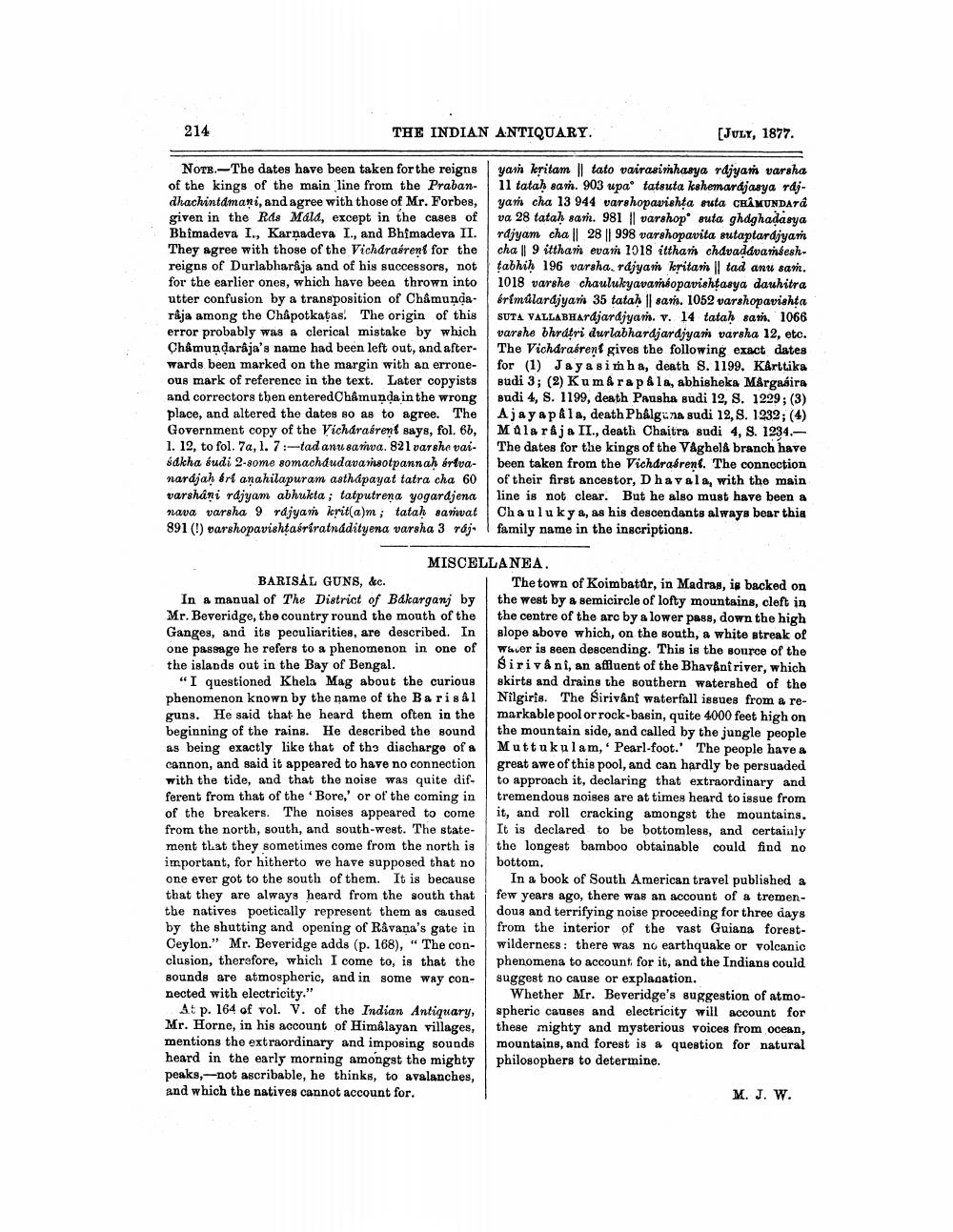________________
214
THE INDIAN ANTIQUARY.
NOTE. The dates have been taken for the reigns of the kings of the main line from the Prabandhachintamani, and agree with those of Mr. Forbes, given in the Ras Máld, except in the cases of Bhimadeva I., Karnadeva I., and Bhimadeva II. They agree with those of the Vicharaérent for the reigns of Durlabharaja and of his successors, not for the earlier ones, which have been thrown into utter confusion by a transposition of Chamunda raja among the Châpotkaṭas. The origin of this error probably was a clerical mistake by which Chamundarâja's name had been left out, and afterwards been marked on the margin with an erroneous mark of reference in the text. Later copyists and correctors then enteredChamunda in the wrong place, and altered the dates so as to agree. The Government copy of the Vicharaérent says, fol. 6b, 1. 12, to fol. 7a, 1. 7:-tad anu samva. 821 varshe vaisakha budi 2-some somachdudavamsotpannaḥ értvanarájaḥ ért anahilapuram asthápayat tatra cha 60 varshani rajyam abhukta; tatputrena yogardjena nava varsha 9 rajyam krit(a)m; tataḥ samvat 891 (!) varshopavishṭasriratnádityena varsha 3 ráj
MISCELLANEA.
BARISAL GUNS, &c.
In a manual of The District of Bákarganj by Mr. Beveridge, the country round the mouth of the Ganges, and its peculiarities, are described. In one passage he refers to a phenomenon in one of the islands out in the Bay of Bengal.
"I questioned Khela Mag about the curious phenomenon known by the name of the Barisal guns. He said that he heard them often in the beginning of the rains. He described the sound. as being exactly like that of the discharge of a cannon, and said it appeared to have no connection with the tide, and that the noise was quite different from that of the 'Bore,' or of the coming in of the breakers. The noises appeared to come from the north, south, and south-west. The statement that they sometimes come from the north is important, for hitherto we have supposed that no one ever got to the south of them. It is because that they are always heard from the south that the natives poetically represent them as caused by the shutting and opening of Râvana's gate in Ceylon." Mr. Beveridge adds (p. 168), "The conclusion, therefore, which I come to, is that the sounds are atmospheric, and in some way connected with electricity."
[JULY, 1877.
yam kritam || tato vairasimhasya rajyam varsha 11 tataḥ sam. 903 upa tatsuta kshemarajasya rájyam cha 13 944 varshopavishta suta CHAMUNDArá va 28 tataḥ sam. 981 || varshop suta ghdghadasya rajyam cha || 28 || 998 varshopavita sutaptarajyam cha 9 ittham evam 1018 ittham chavadávamseshtabhiḥ 196 varsha. rajyam kritam || tad anu sam. 1018 varshe chaulukyavaméopavishtasya dauhitra érímúlardjyam 35 tataḥ || sam. 1052 varshopavishta SUTA VALLABHArdjarájyam. v. 14 tataḥ sam. 1066 varshe bhráṭri durlabhardjardjyam varsha 12, etc. The Vicharaérent gives the following exact dates for (1) Jayasimha, death S. 1199. Kârttika sudi 3; (2) Kumara påla, abhisheka Margaáira sudi 4, S. 1199, death Pausha sudi 12, S. 1229; (3) Ajayapala, death Phalguna sudi 12, S. 1232; (4) Mala raja II., death Chaitra sudi 4, S. 1234.The dates for the kings of the Vaghela branch have been taken from the Vicharaérent. The connection of their first ancestor, Dhavala, with the main line is not clear. But he also must have been a Chauluky a, as his descendants always bear this family name in the inscriptions.
At p. 164 of vol. V. of the Indian Antiquary, Mr. Horne, in his account of Himalayan villages, mentions the extraordinary and imposing sounds heard in the early morning amongst the mighty peaks, not ascribable, he thinks, to avalanches, and which the natives cannot account for.
The town of Koimbatur, in Madras, is backed on the west by a semicircle of lofty mountains, cleft in the centre of the arc by a lower pass, down the high slope above which, on the south, a white streak of Water is seen descending. This is the source of the Sirivâni, an affluent of the Bhavani river, which skirts and drains the southern watershed of the Nilgiris. The Sirivânt waterfall issues from a remarkable pool or rock-basin, quite 4000 feet high on the mountain side, and called by the jungle people Muttukulam, Pearl-foot. The people have a great awe of this pool, and can hardly be persuaded to approach it, declaring that extraordinary and tremendous noises are at times heard to issue from it, and roll cracking amongst the mountains. It is declared to be bottomless, and certainly the longest bamboo obtainable could find no bottom.
In a book of South American travel published a few years ago, there was an account of a tremendous and terrifying noise proceeding for three days from the interior of the vast Guiana forestwilderness there was no earthquake or volcanic phenomena to account for it, and the Indians could suggest no cause or explanation.
Whether Mr. Beveridge's suggestion of atmospheric causes and electricity will account for these mighty and mysterious voices from ocean, mountains, and forest is a question for natural philosophers to determine.
M. J. W.




